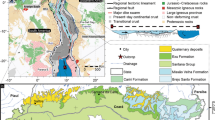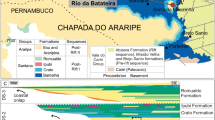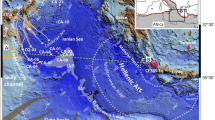Abstract
CORRELATIONS of marine strata using the convenient numerical zones of the Neogene1,2, based on planktonic foraminiferans, represent an important advance in refining and developing greater precision in biostratigraphic correlations. This zona-tion is most effective in tropical and subtropical regions where the nominate planktonic taxa are best developed; progressive difficulty is encountered in applying it away from equatorial areas as these taxa disappear and are replaced by temperate and then by cold-water populations in polar areas. The experimental Mohole (Fig. 1), drilled near Guadalupe Island off Baja California, is significant as far as tropical-temperature planktonic foraminiferal populations are concerned because it is located in a subtropical area in which there is a commingling of tropical and temperate planktonic species3.
This is a preview of subscription content, access via your institution
Access options
Subscribe to this journal
Receive 51 print issues and online access
$199.00 per year
only $3.90 per issue
Buy this article
- Purchase on Springer Link
- Instant access to full article PDF
Prices may be subject to local taxes which are calculated during checkout
Similar content being viewed by others
References
Banner, F. T., and Blow, W. H., Nature, 208, 1164 (1965).
Blow, W. H., Proc. First Internat. Conf. on Planktonic Microfossils, 1, 199 (1969).
Bandy, O. L. and Ingle, jun., J. C., Geol. Soc. Amer. Spec. Paper, 124, 131 (1970).
Parker, F. L., J. Paleontol., 38, 617 (1964).
Ingle, jun., J. C., Bull. Amer. Palaeontol., 52, 217 (1967).
Banner, F. T., and Blow, W. H., Nature, 207, 1351 (1965).
Colalongo, M. L., Giornale di Geologia, 37 (II) 515 (1970).
Bandy, O. L., Twenty-fourth Intern. Geol. Congr. (in the press).
Bandy, O. L., Casey, R. E., and Wright, R. C., Amer. Geophysical Union, Antarctic Res. Ser., 15, 1 (1971).
Dymond, J. R., Science, 152, 1239 (1966).
Larson, R. L., Menard, H. W., and Smith, S. M., Science, 161, 781 (1968).
Natland, M. L., and Kuenen, Ph. H., Soc. Econ. Palaeontologists and Mineralogists, Spec. Publ., 2, 76 (1951).
Wissler, S. G., Calif. Div. Mines and Geol. Bull, 118, 209 (1943).
Bandy, O. L., Calibration of Hominoid Evolution, Symposium 52 (Wenner-Gren Foundation, New York, in the press).
Kennett, J. P., Watkins, N. D., and Vella, P., Science, 171, 276 (1971).
Bandy, O. L., J. Paleontol., 34, 671 (1960).
Kreuger, H. W., J. Geophys. Res., 69, 1155 (1964).
Author information
Authors and Affiliations
Rights and permissions
About this article
Cite this article
BANDY, O. Recognition of Upper Miocene Neogene Zone 18, Experimental Mohole, Guadalupe Site. Nature 233, 476–478 (1971). https://doi.org/10.1038/233476a0
Received:
Issue Date:
DOI: https://doi.org/10.1038/233476a0
This article is cited by
Comments
By submitting a comment you agree to abide by our Terms and Community Guidelines. If you find something abusive or that does not comply with our terms or guidelines please flag it as inappropriate.



